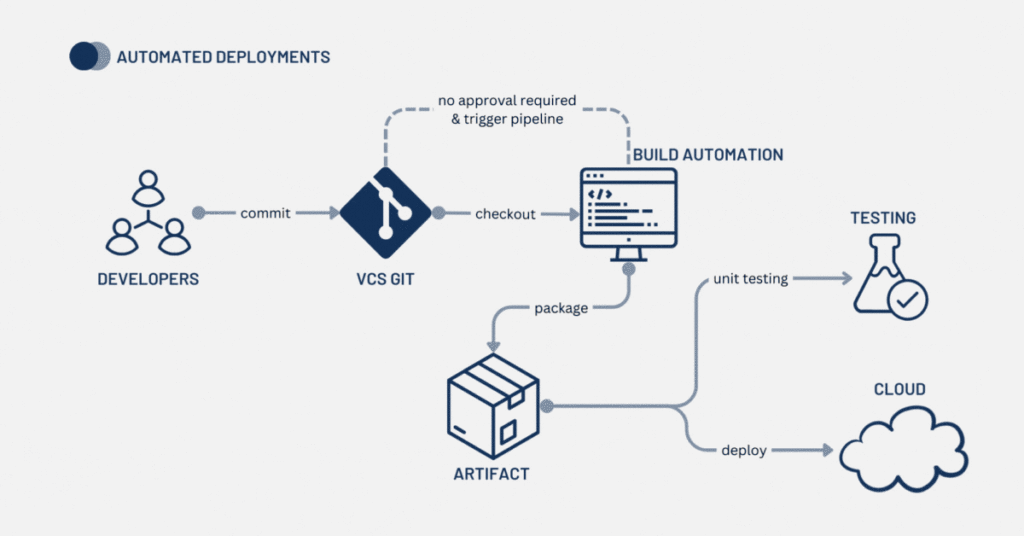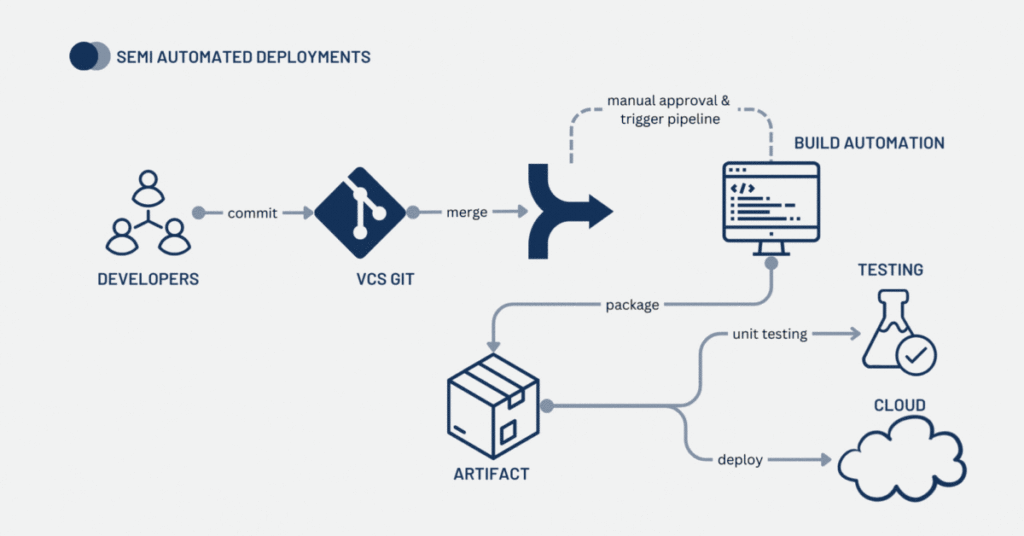In the wild world of software development, nailing the right deployment strategy is key for top-notch applications. The choice of deployment strategy can significantly impact the speed, reliability, and overall success of the software release process.
🚀 We’re diving into the trio of game-changers: Automated, Manual, and the cool cat, Semi-Automated, and discuss their advantages, use cases, and examples. We will also delve into the importance of Continuous Integration/Continuous Deployment (CI/CD) pipelines and the role of DevOps in achieving seamless and efficient software delivery.
Ready? let’s go!
Understanding the Deployment Strategies
1. Automated Deployments: Efficiency and Consistency
Automated deployments involve using tools and scripts to streamline the process of moving code changes from development to various environments. This approach offers several advantages, particularly in testing and staging environments. Automated deployments ensure speed and consistency by reducing human error and the risk of configuration inconsistencies. With automated scripts, every deployment follows the exact same process, ensuring a reliable and consistent environment for testing and staging.
Frequent iterations are a common requirement in testing and staging environments, as developers iterate and refine their code. Automated deployments make it feasible to release changes rapidly, ensuring the most recent version is always available for testing. Additionally, automated deployments facilitate easy rollbacks in case of mistakes or issues, allowing teams to quickly and seamlessly revert to a previous version.
Efficiency is another key benefit of automated deployments. By freeing developers from the manual deployment process, they can focus on coding, testing, and refining the application. This improves productivity and allows for faster time-to-market.

2. Manual Deployments: Risk Mitigation in Production Environments
While automated deployments shine in non-production environments, manual deployments remain the norm for production environments. Several factors contribute to the case for manual deployments in production:
- Risk Mitigation: Production environments directly impact users and business operations, making it crucial to have a human gatekeeper who can carefully review changes and decide when to deploy. Manual deployments provide an opportunity to thoroughly test and validate changes before releasing them to end-users, mitigating the risk of disruptions or downtime.
- Complexity and Variability: Production environments often involve more intricate setups, with scalability, security, and performance optimization considerations. Manual deployments enable teams to tailor the deployment process to these specific considerations, ensuring a seamless transition and avoiding potential issues that automated scripts might overlook.
- Regulatory Compliance: In industries with strict compliance regulations, manual deployments provide a layer of oversight to ensure all compliance requirements are met before introducing changes into a production environment.
- Real-time Monitoring: Manual deployments allow operators to closely monitor the deployment process and its impact on the production environment in real-time. This enables quick identification and resolution of any unexpected behavior before it escalates.
- Cultural and Organizational Factors: Manual deployments in production often align with organizational culture and practices. Stakeholders may feel more confident when decisions are made by human operators, especially for mission-critical applications.
3. Semi-Automated Deployments: Finding the Right Balance
Semi-automated deployments strike a balance between the efficiency of automation and the risk mitigation provided by manual deployments. In this approach, certain parts of the deployment process are automated, while others require human intervention or approval.
Semi-automated deployments are useful when specific steps or decisions in the deployment process require human expertise or validation. For example, the initial deployment of a new feature may involve automated steps, but the final approval and release to production may require manual intervention. This approach allows for flexibility and adaptability while maintaining control over the deployment process.

Use Cases and Examples
To better understand the practical applications of these deployment strategies, let’s explore some use cases and examples.
Use Case 1: Web Application Development
Consider a web application development project. During the development phase, automated deployments are ideal for testing and staging environments. Continuous Integration (CI) tools like Jenkins or GitLab CI/CD pipelines can be used to automatically build, test, and deploy changes to these environments. This approach ensures faster iterations, consistent environments, and efficient collaboration among team members.
As the project moves towards production, a manual deployment strategy is recommended. A dedicated release manager or team can thoroughly review changes, perform final testing, and decide when to release to the production environment. This approach provides an extra layer of control and risk mitigation, ensuring that only stable and validated versions are deployed to end-users.
Use Case 2: Mobile App Release
In the case of mobile app releases, a combination of automated and manual deployments can be effective. Automated deployments can be employed for internal testing and beta releases, where frequent iterations and rapid feedback are essential. CI/CD pipelines can automatically build and deploy the app to testing devices or distribution platforms like TestFlight or Google Play.
However, for the official app store release, a manual deployment strategy is recommended. App store guidelines and review processes often require manual intervention and approval. Human operators can ensure compliance with guidelines, perform final checks, and release the app to the public. This approach allows for greater control and adherence to app store policies.
Use Case 3: Enterprise Software Deployment
In the context of enterprise software deployment, semi-automated deployments can provide the right balance between efficiency and risk mitigation. Automated deployment tools and scripts can handle the majority of the deployment process while allowing for human intervention at critical stages.
For example, an enterprise software update may involve automated steps for database migration and configuration changes. However, the final approval and release to production can be a manual step that requires sign-off from key stakeholders or a change advisory board. This approach ensures a controlled and validated deployment process while leveraging automation for efficiency.
Implementing the Deployment Strategies
To implement the deployment strategies discussed, several tools and practices can be utilized:
- CI/CD Pipelines: Continuous Integration/Continuous Deployment pipelines are essential for automated deployments. Tools like Jenkins, GitLab CI/CD, or AWS CodePipeline enable the automation of build, test, and deployment processes.
- Infrastructure as Code: Infrastructure as Code (IaC) allows for the definition and management of infrastructure resources in a declarative manner. Tools like AWS CloudFormation, Terraform, or Ansible can be used to automate the provisioning and configuration of environments.
- Version Control Systems: Version control systems like Git or GitHub provide a centralized repository for code changes and enable collaboration among team members. They also serve as triggers for automated deployments when changes are pushed to specific branches.
- Testing and Monitoring Tools: Testing frameworks and monitoring tools play a crucial role in ensuring the quality and performance of deployments. Tools like Selenium, JUnit, or AWS CloudWatch provide automated testing and monitoring capabilities.
Conclusion
Choosing how to send your software into the world is like picking the right tool for a programming adventure. 🧰 Automated deployments are the speedy superheroes, shining in safe, non-production territories with their fast and reliable moves. Manual deployments, the guardians of the live show, bring control and safety to the scene. Then, there’s the laid-back Semi-Automated, finding the sweet spot in the middle.
In this coding tale, the best deployment strategy depends on the job, what your team needs, and the rules you follow. Armed with tools like CI/CD pipelines, version control systems, and infrastructure magic, teams can make deploying software smoothly, ensuring top-notch quality and reliability for users.
Here’s the key: getting deployment right comes from making little changes often, teamwork, and diving deep into the software life cycle. Follow the vibe of DevOps, ride the automation wave, and see your apps fly with speed and confidence.
Learn, adapt & code






